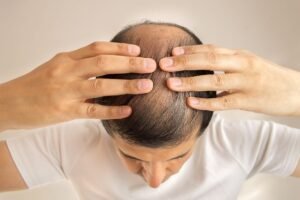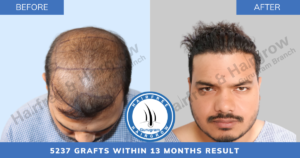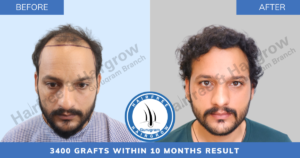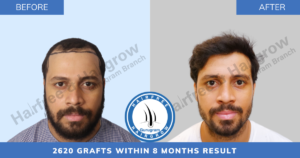Male Hair Loss
What is Male Hair Loss?
 Unfortunately, many men experience hair loss and thinning as they age. Hair loss can occur naturally at times, but it can also be caused by genetic factors. Hair loss can also be caused by being obese or overweight and not following a specific diet.
Unfortunately, many men experience hair loss and thinning as they age. Hair loss can occur naturally at times, but it can also be caused by genetic factors. Hair loss can also be caused by being obese or overweight and not following a specific diet.
It is critical to seek assistance and consult with a medical professional. Hair loss in men can be easily changed in the early stages. The transformation of testosterone to DHT, which causes dandruff and hair thinning, to name a few problems, is the main cause of male hair loss. DHT conversion can be slowed with medications, and hair growth can be accelerated with a hair transplant.
TYPES
1. Androgenetic Alopecia or Male Pattern Baldness
2. Telogen Effluvium
3. Alopecia Areata
Classification of Male Androgenetic Alopecia
1. Patchy Alopecia Aerata
This form of hair loss, which is the most prevalent, causes one or more patches of baldness the size of coins to appear on the scalp or in other areas of the body.
2. Alopecia totalis
This condition causes people to lose all of their scalp hair, or virtually all of it.
3. Universal Alopecia
Universal Alopecia hair loss This form, which is uncommon, is characterised by a total or almost total loss of hair on the scalp, face, and other parts of the body.
Alopecia Areata signs and symptoms
The progression of malepattern baldness is generally classicied on the hanilton – Norwood Scale
Which ranges from Stages I to VII
⦿ Type-I Minimal hair loss along sides and front part
⦿ Type-II Recession of hair line at both sides along with frontal hair thinning.
⦿ Type-III Deep, Symmetrical side hair-line receding
⦿ Type-IV Extending front and side hair line along with significant hair loss in crown area.
⦿ Type-V Extensive alopecial(baldness) in front and temporal and vertex region.
⦿ Type-VI There is complete absence of hair in the bridge joining the vertex and front temporal region.
⦿ Type-VII Most server varient with almost bald head look with horse- shoe shaped hairy zone at the sides.
Treatments for Male hair loss
Finasteride
As the active androgen in male baldness, DHT. 1Mg taken orally once a day Finasteride promotes hair loss and stimulates modest hair regrowth in approximately 50% of people. It is also well-tolerated.
Minoxidil
It is a liquid that comes in 2%, 5% lotion, 5% foam, and 10% lotion concentrations. It promotes hair growth by applying it topically to the scalp once or twice daily; it also improves blood supply to the follicle; patients must use minoxidil for at least 6 months to access the reaction and treatment must be continued to maintain the response
Biotin
Biotin, also known as vitamin B7, is a water-soluble vitamin that pertains to the vitamin B family. It is in charge of many metabolic functions in your body, particularly the conversion of food into energy. If you
Hair transplant is a type of surgery in which existing hair is moved to fill a bald or thinning area. Doctors have been performing these transplants in the United States since the 1950s, but techniques have evolved significantly in recent years.
The procedure is usually performed in the doctor’s office. First, the surgeon cleans your scalp and injects medicine into the back of your head to numb it. Your doctor will select one of two transplant methods: follicular unit strip surgery (FUSS) or follicular unit extraction. Doctors may prescribe an oral multivitamin or a hair vitamin supplement.
Hair Transplantation
Hair Transplant surgery is carried out under local anesthesia and can be done in 1 or 2 consequent days depending upon the number of hair grafts. It involves moving hair follicles from non-androgen dependent back of scalp into the frontal balding areas. which can give excellent, desired results
Hair Loss
⦿ About Hair Loss
⦿ Male Hair Loss
⦿ Female Hair Loss
⦿ Androgenetic Alopecia
⦿ Alopecia Areata
⦿ Traction Alopecia
⦿ Anagen Effluvium
⦿ Telogen Effluvium
⦿ Cicatricial Alopecia
⦿ Folliculitis
Before and After








